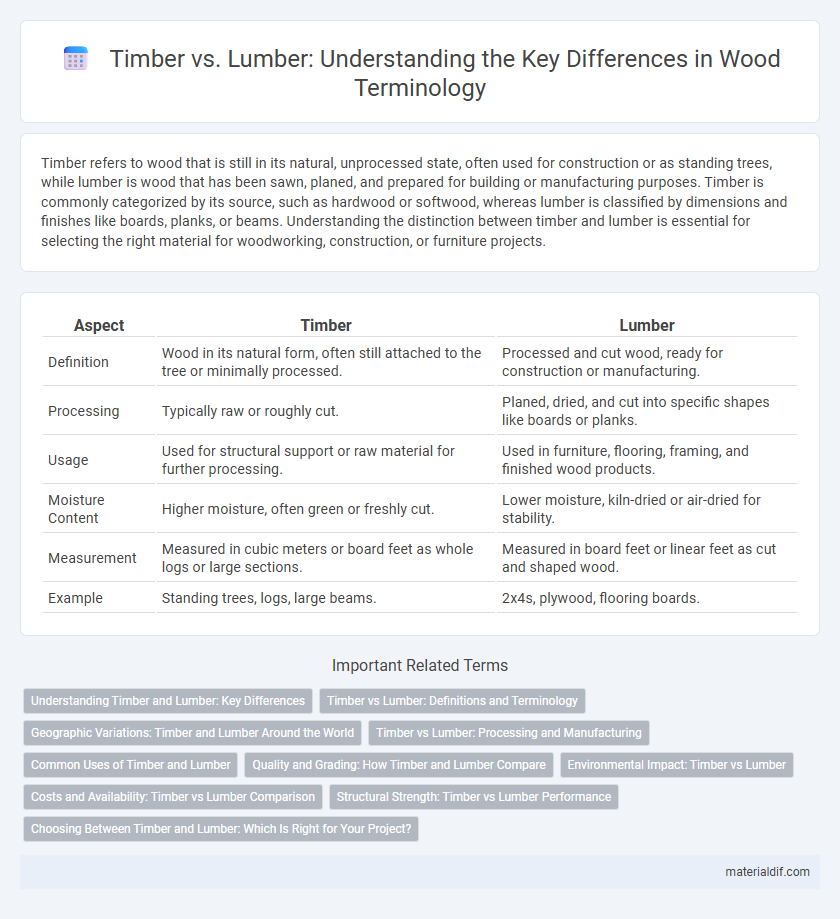Timber refers to wood that is still in its natural, unprocessed state, often used for construction or as standing trees, while lumber is wood that has been sawn, planed, and prepared for building or manufacturing purposes. Timber is commonly categorized by its source, such as hardwood or softwood, whereas lumber is classified by dimensions and finishes like boards, planks, or beams. Understanding the distinction between timber and lumber is essential for selecting the right material for woodworking, construction, or furniture projects.
Table of Comparison
| Aspect | Timber | Lumber |
|---|---|---|
| Definition | Wood in its natural form, often still attached to the tree or minimally processed. | Processed and cut wood, ready for construction or manufacturing. |
| Processing | Typically raw or roughly cut. | Planed, dried, and cut into specific shapes like boards or planks. |
| Usage | Used for structural support or raw material for further processing. | Used in furniture, flooring, framing, and finished wood products. |
| Moisture Content | Higher moisture, often green or freshly cut. | Lower moisture, kiln-dried or air-dried for stability. |
| Measurement | Measured in cubic meters or board feet as whole logs or large sections. | Measured in board feet or linear feet as cut and shaped wood. |
| Example | Standing trees, logs, large beams. | 2x4s, plywood, flooring boards. |
Understanding Timber and Lumber: Key Differences
Timber refers to wood that is still in its natural, unprocessed state, often used for construction and woodworking in its raw form. Lumber, on the other hand, is timber that has been processed, cut, and finished into standardized sizes suitable for building and manufacturing. Understanding the key differences between timber and lumber helps in selecting the right material for projects related to carpentry, furniture making, and structural applications.
Timber vs Lumber: Definitions and Terminology
Timber refers to wood that is still in its natural state or only partially processed, often used in construction and woodworking before being cut into specific dimensions. Lumber, on the other hand, denotes wood that has been sawn, planed, and finished into standardized sizes for building or furniture making. Understanding the distinction between timber as raw or partially processed wood and lumber as finished wood products is crucial in the woodworking and construction industries.
Geographic Variations: Timber and Lumber Around the World
Timber and lumber terminology varies significantly across regions, with "timber" commonly used in British English to describe wood prepared for construction, while "lumber" is the preferred term in North America. In Australia and New Zealand, "timber" refers to both standing trees and processed wood, reflecting a broader usage. These geographic variations influence the wood industry's vocabulary, affecting trade, construction standards, and woodworking practices globally.
Timber vs Lumber: Processing and Manufacturing
Timber refers to trees that have been felled and prepared for further processing, often encompassing raw or minimally processed wood directly from the forest. Lumber is the result of timber being sawn, planed, and finished into standardized dimensions for construction and manufacturing purposes. The processing of timber into lumber involves drying, cutting, and sometimes treating to enhance durability and usability in building projects.
Common Uses of Timber and Lumber
Timber is commonly used in construction for framing houses, building beams, and structural supports due to its strength and durability. Lumber is typically processed and cut into smaller, standardized sizes ideal for furniture making, cabinetry, and interior finishes. Both materials serve essential roles in woodworking and construction, with timber favored for heavy-duty applications and lumber preferred for detailed craftsmanship.
Quality and Grading: How Timber and Lumber Compare
Timber and lumber differ significantly in quality and grading standards, with timber typically referring to raw, minimally processed wood, often graded for structural integrity in construction. Lumber undergoes more refined processing and is graded based on appearance, strength, and moisture content, making it suitable for furniture and detailed woodworking projects. Grading systems like the National Hardwood Lumber Association (NHLA) for lumber ensure consistent quality, whereas timber grading follows standards such as visual assessment for defects and size classification.
Environmental Impact: Timber vs Lumber
Timber harvesting often involves sustainable forestry practices that promote reforestation and biodiversity, leading to a lower environmental footprint compared to lumber production, which typically requires extensive processing and chemical treatments. Timber's carbon sequestration ability during growth helps reduce greenhouse gases, while lumber manufacturing generates higher energy consumption and waste. Choosing timber over processed lumber supports eco-friendly construction by minimizing habitat destruction and promoting renewable resource cycles.
Costs and Availability: Timber vs Lumber Comparison
Timber generally incurs higher costs due to its raw, unprocessed state, which requires additional milling and treatment before use. Lumber is more readily available at local suppliers and is often less expensive because it is processed and standardized, reducing the need for further preparation. The cost-effectiveness and accessibility of lumber make it preferable for most construction projects, while timber suits specialized applications needing whole, untreated wood.
Structural Strength: Timber vs Lumber Performance
Timber generally refers to wood in its natural, unprocessed form and tends to retain higher structural strength due to fewer alterations. Lumber, which is wood that has been processed, dried, and cut, offers more uniformity but can have reduced strength depending on treatments and manufacturing methods. Structural performance depends on species, moisture content, and grading standards, with timber often preferred for heavy-load applications where maximum durability is critical.
Choosing Between Timber and Lumber: Which Is Right for Your Project?
Timber refers to raw, unprocessed wood often used in construction and rustic projects, while lumber is milled wood that has been cut and shaped for specific building purposes. When choosing between timber and lumber, consider the project's structural requirements, aesthetic preferences, and budget constraints; timber suits outdoor or heavy-duty applications, whereas lumber offers precision and ease for interior work. Evaluating factors like durability, treatment options, and availability ensures the right material enhances both functionality and design.
Timber vs Lumber Infographic

 materialdif.com
materialdif.com